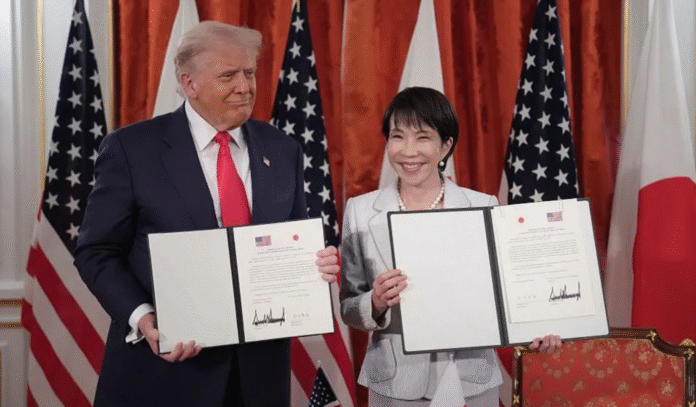The Trump Japan Asia tour made global headlines this week as former U.S. President Donald Trump wrapped up the Japan leg of his journey with a mix of diplomacy, pageantry, and unexpected announcements. From rare earth mineral deals to a Nobel Peace Prize nomination, Trump’s meeting with Japan’s newly elected Prime Minister Sanae Takaichi marked a defining moment in U.S.–Japan relations.
Trump Japan Asia Tour Begins with a Grand Welcome
From the moment Trump arrived in Tokyo, the Trump Japan Asia tour was nothing short of spectacular. Japan’s Prime Minister Sanae Takaichi rolled out the red carpet, hosting the U.S. leader at the magnificent Akasaka Palace, a venue known for its gold-embellished halls and royal grandeur.

Takaichi, Japan’s first female prime minister, praised Trump’s global leadership and pledged to strengthen economic and defense ties. In return, Trump showered her with compliments, saying the U.S. would support Japan in “anything you want, any favors you need.”
The two leaders also signed a historic rare earth minerals deal, aimed at reducing dependency on China, a move that could reshape global supply chains.
Rare Earths Deal Marks New “Golden Age”
A key outcome of the Trump Japan Asia tour was the signing of an agreement on rare earth minerals, essential for electronics, defense technologies, and clean energy. Both nations also endorsed a document celebrating a new “Golden Age of U.S.–Japan Relations.”
This pact reaffirmed earlier trade commitments, including the 15% tariff reduction deal finalized earlier in 2025. Experts say the rare earths partnership could shift control away from China, which currently dominates global production.
Trump hailed the deal as a victory for “innovation and freedom,” signaling a strong stance on economic independence.
Takaichi Praises Trump, Announces Nobel Nomination
In a symbolic gesture, Prime Minister Sanae Takaichi announced that Japan would nominate Trump for the Nobel Peace Prize, citing his efforts to promote peace in the Middle East. The announcement drew both applause and controversy online.
Takaichi also presented Trump with a set of personalized golf gifts, including a signed bag by Hideki Matsuyama, the first Japanese man to win a major golf title, and a putter once used by former Prime Minister Shinzo Abe, Trump’s late ally.
Trump, visibly moved, called Takaichi a “close friend” and described the U.S, Japan relationship as “a beautiful friendship born from the ashes of war.”
Aboard the USS George Washington: A Show of Strength
The Trump Japan Asia tour also included a powerful military display aboard the USS George Washington, where Trump and Takaichi were welcomed by thousands of cheering American troops.
Takaichi used the moment to reaffirm Japan’s commitment to increased defense spending, calling the alliance “the greatest in the world.”
This show of unity comes after Trump previously criticized Japan’s “one-sided” defense treaty, arguing the U.S. bore too much of the cost.
Trade, Tariffs, and the $10 Billion Investment Promise
Behind the diplomatic smiles, serious trade talks took center stage. During a private working lunch, Takaichi presented Trump with a map highlighting Japanese investments in the U.S.
Trump later revealed that Toyota plans to invest $10 billion in new factories across America, a promise he called “a big win for American workers.”
However, Trump also pushed for more market access for U.S. exports, including rice, soybeans, and vehicles. He emphasized that Japan must open its markets more fully if it wants continued tariff relief.
For context, Japan’s auto industry, its biggest export sector, recently benefited from the reduction of U.S. tariffs from 24% to 15%, leveling the playing field with competitors like South Korea.
A Strategic Balancing Act for Japan
Political analysts note that Takaichi faces one of the toughest balancing acts in modern Japanese history. She must strengthen ties with Washington while avoiding a rift with Beijing, Japan’s biggest trading partner.
According to Rintaro Nishimura, senior associate at the Asia Group, “Takaichi will have to walk a fine line—softening her hawkish tone on China while convincing Trump that Japan remains America’s most reliable ally.”
Former Abe adviser Tomohiko Taniguchi also weighed in, saying that Takaichi can draw from Abe’s approach: be direct, protect Japan’s interests, and ensure the nation’s defense stays in its own hands.
The Symbolism Behind the Pageantry
The Trump Japan Asia tour was as much about symbolism as policy. Every detail, from the military guard of honor to the gold-draped banquet hall, was crafted to appeal to Trump’s taste for grandeur.
Even the lunch menu blended diplomacy with subtle messaging: “American rice and beef made with Japanese ingredients.” For Trump, who has long demanded Japan buy more U.S. agricultural goods, the gesture was clearly designed to please.

What’s Next for Trump’s Asia Tour?
As the Japan leg of the Trump Japan Asia tour concludes, Trump is heading to South Korea, followed by a planned meeting with China’s President Xi Jinping. Observers are watching closely to see if the momentum from Japan carries into these high-stakes meetings.
For now, Trump leaves Japan with a rare earths deal, a Nobel nomination, and renewed alliance promises, but questions remain about how sustainable this new “Golden Age” will be amid global tensions.

